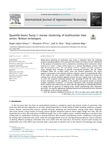Mostrar o rexistro simple do ítem
Quantile-based fuzzy C-means clustering of multivariate time series: Robust techniques
| dc.contributor.author | López-Oriona, Ángel | |
| dc.contributor.author | D'Urso, Pierpaolo | |
| dc.contributor.author | Vilar, José | |
| dc.contributor.author | Lafuente Rego, Borja Raúl | |
| dc.date.accessioned | 2023-01-02T09:47:46Z | |
| dc.date.available | 2023-01-02T09:47:46Z | |
| dc.date.issued | 2022-11 | |
| dc.identifier.citation | Á. López-Oriona, P. D’Urso, J. A. Vilar, and B. Lafuente-Rego, “Quantile-based fuzzy C-means clustering of multivariate time series: Robust techniques,” Int J Approx Reason, vol. 150, pp. 55–82, 2022. doi: 10.1016/j.ijar.2022.07.010 | es_ES |
| dc.identifier.uri | http://hdl.handle.net/2183/32273 | |
| dc.description | Financiado para publicación en acceso aberto: Universidade da Coruña/CISUG | es_ES |
| dc.description.abstract | [Abstract]: Robust fuzzy clustering of multivariate time series is addressed when the clustering purpose is grouping together series generated from similar stochastic processes. Robustness to the presence of anomalous series is attained by considering three well-known robust versions of a fuzzy C-means model based on a spectral dissimilarity measure with high discriminatory power. The dissimilarity measure compares principal component scores obtained from estimates of quantile cross-spectral densities, and the robust techniques follow the so-called metric, noise and trimmed approaches. The metric approach incorporates in the objective function a distance aimed at neutralizing the effect of the outliers, the noise approach builds an artificial cluster expected to contain the outlying series, and the trimmed approach removes the most atypical series in the dataset. As result, the proposed clustering methods take advantage of both the robust nature of these techniques and the capability of the quantile cross-spectral density to identify complex dependence structures. An extensive simulation study including multivariate linear, nonlinear and GARCH processes shows that the algorithms are substantially effective in coping with the presence of outlying series, clearly outperforming other alternative procedures. Two specific applications regarding financial and environmental series illustrate the usefulness of the presented methods. | es_ES |
| dc.description.sponsorship | Ministerio de Economía y Competitividad (MINECO); MTM2017-82724-R | es_ES |
| dc.description.sponsorship | Ministerio de Economía y Competitividad (MINECO); PID2020-113578RB-100 | es_ES |
| dc.description.sponsorship | Xunta de Galicia; ED431C-2020-14 | es_ES |
| dc.description.sponsorship | Centro de Investigación en Tecnologías de la Información y las Comunicaciones (CITIC); ED431G 2019/01 | es_ES |
| dc.language.iso | eng | es_ES |
| dc.publisher | Elsevier | es_ES |
| dc.relation.uri | https://doi.org/10.1016/j.ijar.2022.07.010 | es_ES |
| dc.rights | Atribución 40 Internacional (CC BY 4.0) | es_ES |
| dc.rights.uri | http://creativecommons.org/licenses/by/3.0/es/ | * |
| dc.subject | Exponential distance | es_ES |
| dc.subject | Multivariate time series | es_ES |
| dc.subject | Robust fuzzy C -means | es_ES |
| dc.subject | Quantile cross-spectral density | es_ES |
| dc.subject | Exponential distance | es_ES |
| dc.subject | Noise cluster | es_ES |
| dc.subject | Trimming | es_ES |
| dc.subject | Fuzzy clustering | es_ES |
| dc.subject | Spectral density | es_ES |
| dc.subject | Stochastic systems | es_ES |
| dc.subject | Time series | es_ES |
| dc.title | Quantile-based fuzzy C-means clustering of multivariate time series: Robust techniques | es_ES |
| dc.type | info:eu-repo/semantics/article | es_ES |
| dc.rights.access | info:eu-repo/semantics/openAccess | es_ES |
| UDC.journalTitle | International Journal of Approximate Reasoning | es_ES |
| UDC.volume | 150 | es_ES |
| UDC.startPage | 55 | es_ES |
| UDC.endPage | 82 | es_ES |
| dc.identifier.doi | 10.1016/j.ijar.2022.07.010 |
Ficheiros no ítem
Este ítem aparece na(s) seguinte(s) colección(s)
-
GI-MODES - Artigos [143]






